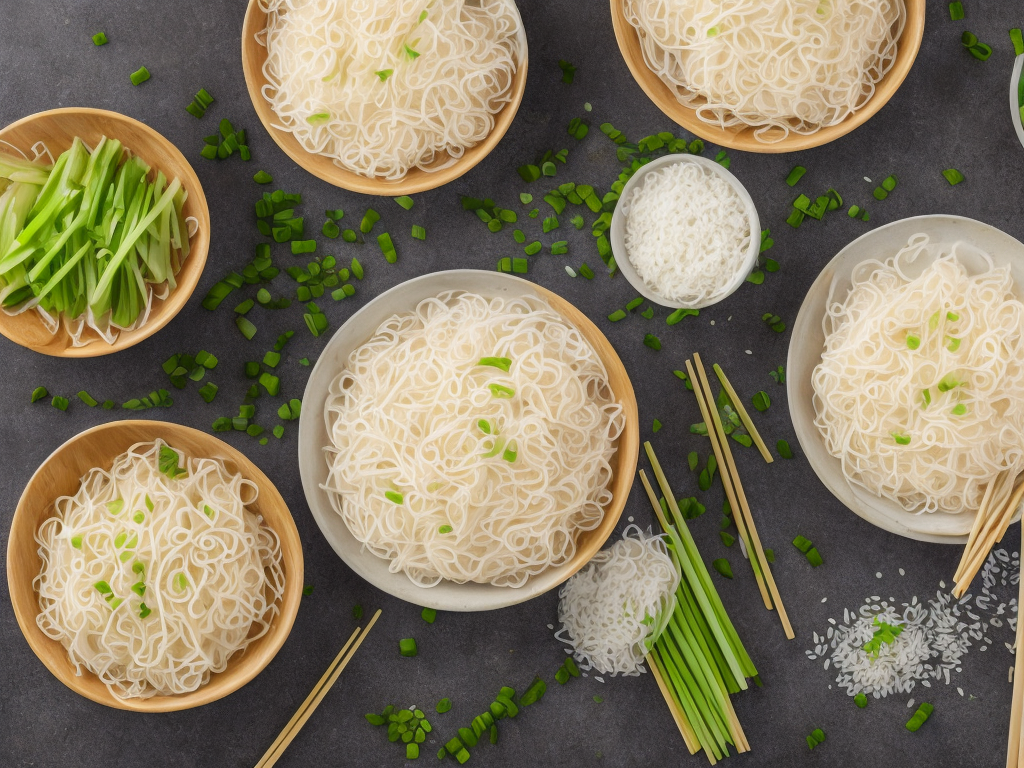
Rice noodles are a popular staple food in many Asian countries, especially in China, Thailand, and Vietnam. They are versatile and can be used in many dishes, including stir-fries, soups, salads, and curries. Making rice noodles from scratch may seem daunting, but it is actually quite simple if you follow the right steps.
In this article, we will guide you through the process of making rice noodles at home using just a few basic ingredients and tools. Once you master this technique, you can experiment with different noodle shapes, sizes, and flavors to create your own signature dishes.
Ingredients:
- Rice flour (2 cups)
- Cornstarch (1/2 cup)
- Salt (1/2 teaspoon)
- Water (around 1 1/2 cups)
- Oil (1 tablespoon)
Tools:
- Mixing bowl
- Wooden spoon or spatula
- Large pot or wok
- Bamboo steamer or colander
- Cheesecloth or thin cotton cloth
- Rolling pin or pasta machine
Steps:
1. In a mixing bowl, combine rice flour, cornstarch, and salt. Mix well.
2. Gradually add water to the flour mixture while stirring with a wooden spoon or spatula. Keep adding water until you get a smooth and elastic dough. You may not need to use all the water, or you may need a little more, depending on the texture of your flour and the humidity level of your kitchen.
3. Knead the dough for about 10 minutes until it becomes soft and pliant. If the dough is too dry, add a little more water. If it is too wet, add a little more rice flour.
4. Form the dough into a ball and brush it with oil to prevent it from drying out. Cover the bowl with a damp cloth and let it rest for at least 30 minutes or up to 2 hours. This will allow the gluten in the dough to relax and the flavor to develop.
5. When ready, bring a large pot or wok of water to a boil. You can add a few drops of oil or salt to the water to prevent the noodles from sticking together.
6. While waiting for the water to boil, set up your bamboo steamer or colander over the pot. Line it with cheesecloth or thin cotton cloth.
7. Divide the dough into small portions (about the size of a golf ball) and flatten each one with your hands or a rolling pin into a thin sheet about 1/4 inch thick. You can also use a pasta machine to roll out the dough.
8. Cut the sheet of dough into long and thin strips (about 1/4 inch wide), using a knife or a pizza cutter. You can also use a pasta cutter or a straight-edged ruler.
9. Place the strips of dough on the cheesecloth or cotton cloth in the steamer or colander. Be careful not to overlap them or they will stick together.
10. Steam the noodles over high heat for about 2-3 minutes or until they become translucent and tender. You can stir them gently with chopsticks or tongs to separate them.
11. Remove the noodles from the steamer or colander and rinse them briefly under cold water to remove any leftover starch. Drain them well.
12. You can store the noodles in the fridge or freezer, wrapped in plastic or in an airtight container, for up to a week. To use them, simply stir-fry them with your favorite vegetables, meats, or sauces, or add them to soups or stews.
Tips:
- If you want to add flavor and color to your rice noodles, you can use vegetable juices, such as spinach, carrot, or beetroot, instead of water in the dough. This will give the noodles a green, orange, or purple hue respectively.
- You can also add herbs, spices, or oils to the dough, such as garlic, ginger, sesame oil, or chili flakes, to enhance the flavor and aroma of the noodles.
- To make thicker or wider noodles, adjust the size and thickness of the dough before cutting them into strips. You can also fold the sheet of dough a few times and cut them into thicker ribbons or squares.
- Instead of steaming the noodles, you can also dry them in the sun or in a warm and well-ventilated place until they become crispy. These dried noodles can be stored for months and used as a snack or a garnish.
- If you don't have a bamboo steamer or a colander, you can use any other heatproof container with holes or slits, such as a metal strainer or a plastic basket.
- Always use rice flour, not wheat flour, to make rice noodles. Wheat flour contains gluten, which will make the noodles chewy and elastic, whereas rice flour is gluten-free and more delicate.
- Cornstarch is added to the dough to make it more elastic and resistant to breaking. You can substitute it with tapioca starch or potato starch if you prefer.
- Be careful not to overcook the noodles, as they will become mushy and lose their texture. Undercooked noodles will be tough and chewy. The ideal texture should be soft and slightly chewy, but not mushy or gummy.
 Self-Instruct
Self-Instruct